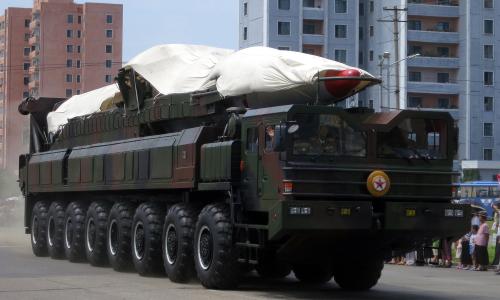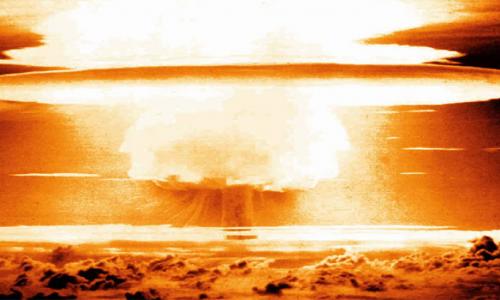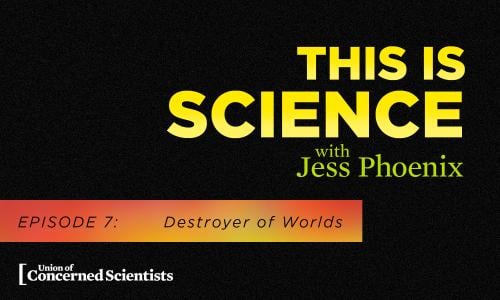Most Americans are not aware that today—almost 20 years after the end of the Cold War—the United States and Russia still have roughly 7,000 nuclear weapons targeted against each other's urban industrial centers and military sites. These thermonuclear weapons (hydrogen bombs) are much more powerful than the atomic bombs used on Hiroshima and Nagasaki. Together, their combined explosive energy adds up to that of over 100,000 Hiroshima bombs. Even worse, each country maintains over a thousand of their missile-launched warheads on hair-trigger alert, ready to launch within a few minutes. An accidental or unauthorized Russian nuclear attack, or a deliberate attack launched in response to false information, remains a grave risk to the United States.
If one nuclear weapon exploded above downtown Denver, some 60,000 people would die within hours, and an equal number would be seriously injured.[1]
Even one typical Russian nuclear weapon detonated above downtown Denver would have devastating consequences. The nuclear explosion would produce a high-pressure shock wave, and tremendous amounts of light and heat. The shock front would destroy buildings and be followed by intense hurricane-like winds reaching speeds of several hundred miles per hour or more. The heat would severely burn anyone exposed to it and ignite large scale fires.
Blast: As the high-pressure shock wave expanded, it would collapse houses and buildings over a wide area. The blast would level all buildings and kill everyone within a mile of the explosion. Unreinforced buildings out to 2 miles would collapse or be destroyed, killing almost everyone in this region. Most buildings out to 3 miles would collapse or be destroyed, killing about half the people in them and injuring the rest. Homes would be destroyed or seriously damaged and more substantial buildings damaged out to 5 miles, injuring about half the occupants. In addition, many people outdoors would be killed or injured by high-speed flying debris.
Heat: The heat produced by the nuclear explosion would directly burn exposed people outside and ignite fires. Within four to five miles, fabric and other household materials would spontaneously ignite, in some cases setting serious fires, which could coalesce into a firestorm fed by intense winds. In addition, for people not shielded by a building, almost everyone within 5 miles would receive third-degree burns, and most within 6 miles would receive third- or second-degree burns.[2] Most people with third-degree burns, and many with second-degree burns, will go into shock and die unless they receive prompt specialized medical care—which would not be available.
Nuclear Fallout
The explosion would also produce large amounts of highly radioactive dust and debris (nuclear fallout), which could be carried long distances by the wind.[3] The contaminated area would depend on many factors, including the wind speed and direction, and whether it is raining or snowing. For a typical wind in Denver,[4] the fallout would eventually contaminate many thousands of square miles.
The map gives a rough estimate of the accumulated radiation dose people would receive after 24 hours. Everyone in the inner region would die, as would well over half of those in the middle region. The remaining people in the middle region would suffer acute radiation sickness, as would those in the outer region. Even if these people recovered in the short term, their chance of later developing cancer would increase.[5] Beyond these regions, the fallout would result in lower levels of contamination over a large area, and those exposed would also have an increased lifetime risk of cancer.
Needed: A Fundamentally Different U.S. Nuclear Weapons Policy
To reduce the risk of an accidental or unauthorized attack from Russia, the next president must make fundamental changes to U.S. nuclear weapons policy. He should remove U.S. nuclear weapons from hair-trigger alert, giving Russia a strong incentive to reciprocate. He should declare that the sole purpose of U.S. nuclear weapons is to deter their deliberate use against the United States and its allies by other nations. Because such deterrence requires few nuclear weapons, the United States should substantially reduce its nuclear arsenal, and its goal should be the eventual elimination of nuclear weapons.[6] As former Secretaries of State George Shultz and Henry Kissinger (both Republicans), and former Secretary of Defense William Perry and former Senator Sam Nunn (both Democrats) have argued, unless the United States takes serious steps toward a "world free of nuclear weapons," more nations and eventually terrorists will acquire nuclear weapons.[7]
[1] We assume the weapon has an explosive power of a typical Russian warhead—550 kilotons, which is equivalent to that of 550,000 tons of TNT, and that it explodes at a height of 2000 feet over the city.
[2] This assumes a clear day, with a visibility of 12 miles.
[3] If the warhead exploded at an altitude lower than 2000 feet, the fallout would increase; for higher altitudes, it would decrease.
[4] The average wind speed in Denver is 9 miles per hour.
[5] The contours correspond to a whole body dose after an exposure of 24 hours of 1000, 450 and 150 rems, respectively (a radiation dose is measured in rems). The lethal dose of radiation varies from person to person and depends on whether or not they receive medical treatment. Doses above 1000 rem are fatal. Roughly half of the people receiving a dose of 450 rem will die, and people receiving more than 150 rem will suffer from radiation sickness.
[6] For more details, see Toward True Security: Ten Steps the Next President Should Take to Transform U.S. Nuclear Weapons Policy at www.ucsusa.org/global_security/nuclear_weapons/truesecurity.html
[7] George P. Shultz, William J. Perry, Henry A. Kissinger, and Sam Nunn, "A World Free of Nuclear Weapons," Wall Street Journal, January 8, 2007.



